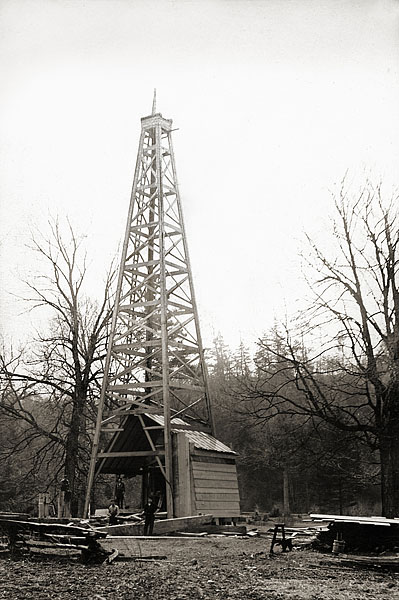Building Rigs the Old Way
Oilman U.S. Dye
By Steve Dye

A oil derrick under construction by Ulysses S. Grant “Lyss” Dye, and crew, near Elkins, in about 1910. Photographer unknown
I never knew my Granddad Dye very well, since I was only eight when he passed away. Still, it seems like I knew him quite well, due to the many things that my father, Junior Dye, and my great-aunt, Mary Devol, told me about him. He was born in 1880 on Johnson Run, Wood County, at the home of his half sister, Emma Johnson. With the Civil War still fresh in most people’s minds, he was given the name Ulysses Simpson Grant Dye, though he was soon known to most folks as “Lyss.”
He once told my uncle, Delbert Canary, that he’d been a “scaredy cat” until he was 12 years old. Sometime during that year, he was jumped by a couple of 16 year olds, who told him they were going to give him a “good lickin’.” Lyss knew that he hadn’t done anything to deserve such treatment so, in a fit of righteous indignation, he managed to turn the tables and gave the both of them a sound thrashing instead. He wasn’t much scared of anything or anybody after that.
Like most country kids of that era, Granddad left school after the eighth grade to earn his own way in life. He went to work in the oilfields and learned the trade of rig building. By age 19, he was a rig-building contractor with his own crew of men. As much as possible, he used friends, neighbors, and relatives as crew, since he already knew their talents and work habits. They, in turn, often brought him business when they or their acquaintances needed rigs built for leases on their farms. Once oil was discovered on a piece of property, an oil rig — or derrick — needed to be built before drilling could take place. Drilling sometimes thousands of feet into the earth, drillers needed strong, reliable rigs.
While a few drillers built their own rigs, most contracted the job out to rig builders like Granddad. Most often, the oil company that held the lease arranged and paid for such services. Granddad did a lot of work for South Penn Oil Company. Drillers brought a lot of work to him by requesting that the oil companies use Lyss whenever possible, due to the excellent alignment of his rigs. The drillers bragged that all they had to do with one of Lyss Dye’s rigs was to throw on the belts and go to work, whereas some rig builders left the drillers with a lot of shimming and adjusting to do.
You can read the rest of this article in this issue of Goldenseal, available in bookstores, libraries or direct from Goldenseal.